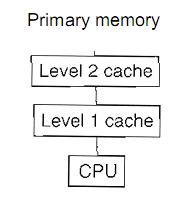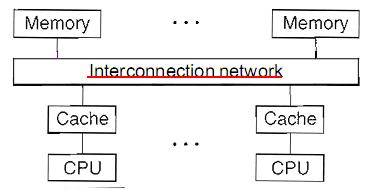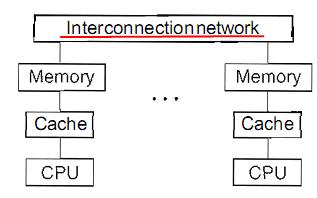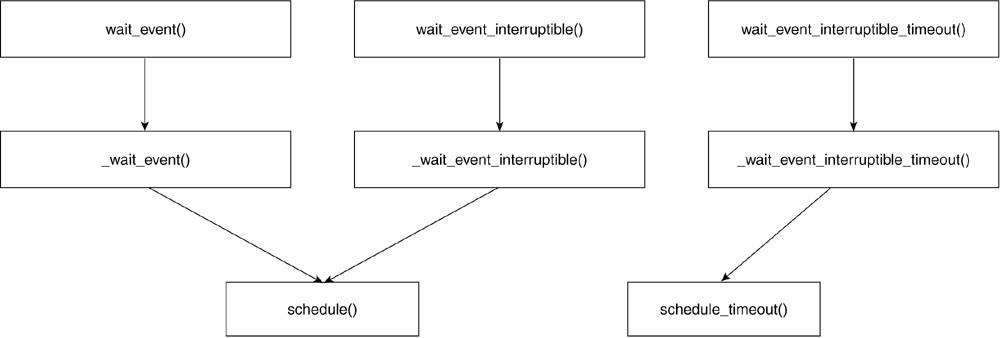【深入剖析Linux内核】Linux内核之旅--(三)同步
2013-08-10 18:47
323 查看
1、概述
同步问题是操作系统中的经典问题,它伴随着并发处理而自诞生。现代体系结构中常见的并发处理情况可以分为如下三种情况:
(1)多个线程在单处理器上执行——多线程编程
(2)多个线程在多处理器上执行——并行计算
(3)多个线程在分布的多个处理上执行——分布式计算
相应的编程也分成三种情况:
共享变量编程、分布式(基于消息)编程和并行编程。
1.1、并发程序设计的本质
并发程序通常包括两个或多个进程一起工作,共同完成一项任务,于是进程(线程)间的通信产生,也就产生了同步问题。进程(或者线程)间需要通信是产生同步的根本原因,正是因为需要通信,才需要同步。进程之间有两种通信方式:共享变量(shared
variables)和消息传递(message passing)。使用共享变量时,一个进程对变量进行写操作,另一个进程进行读操作。使用消息传递时,一个进程发送消息,一个进程接收消息。不管使用哪种通信方式,进程之间需要进行同步。有两种基本的同步方式:互斥(mutual
exclusion)和条件同步(condition
synchronization)。互斥保证关键代码段不会同一时刻执行。条件同步会阻塞进程,直到相应的条件发生。例如,对于通过共享内存方式来实现通信生产者和消费者进程,互斥变量保证生产者访问内存时,消费者不会访问内存。条件同步保证生产者写数据之前,消费者不会读数据。
同步的根本目的是创建临界区(critical region)或者等待特定的条件,常用的方式有:锁(lock)、信号量(semaphore)和管程(monitor)。前两者在Linux都有实现,最后一种方式一般在用户态层面实现(比如Java就是采用管程来实现同步原语的)。
并发编程的硬件来源:中断和多处理器。
1.2、硬件架构
常见而流行的三种计算机架构:(1)单处理器和内存(2)共享内存多处理器(3)分布式内存,包括多计算机和计算机网络。
1.2.1、单处理器体系结构

1.2.2、共享内存多处理器
处理器与内存之间通过互连网络连接起来。小规模的多处理器计算机可以包括30个处理器不等。互连网络通过内存总路(memory bus)或交换开关(crossbar switch)来实现。这种架构通常叫做UMA计算机,因为每个处理器和内存之间有相同的访问机会。UMA机器也叫做SMP。

1.2.3、分布式内存多处理器
在分布式内存多处理器结构中,也存在用于通信的互连网络,但是每个处理器都有它自己的私有内存(private memory)。

这种结构使用消息传递,而不是读写内存;不存在缓存和内存一致性问题。
为了利用多个处理器,有三种应用程序:多线程系统、分布式系统和并行计算。
2、Linux内核同步
Linux内核中产生并发处理的硬件来源有两个:中断和多CPU。其基本同步方式有四种:关闭中断(只对本地CPU)、原子操作(atomic operation)、自旋锁(spin lock)和信号量。原子操作实际上只是对CPU原子指令的简单包装,它的原子性由硬件保证。而硬件提供的原子指令是实现锁和信号量的基础。
对于内核态,CPU可能处于两处不同的内核控制路径:中断处理和异常处理(包括系统调用)。对中断处理程序,在单CPU下,可以通过禁止中断实现临界区;在多CPU下,可以通过自旋锁实现临界区。对异常处理程序,在单CPU下,可以通过禁止内核抢占实现临界区;在多CPU下,可以通过信号量实现临界区。
2.1、自旋锁(spin lock)
自旋锁主要是针对多CPU的,它是一种忙等待形式的同步(所以浪费CPU机器周期),主要用于中断处理。对于由自旋锁保护的临界区,会禁止内核抢占。对于单CPU,自旋锁除了禁止(或者开启)内核抢占外,什么也不做。
2.1.1、硬件支持
在X86平台下,可以对如下一些指令加上LOCK前缀来保证指令的原子性执行:
(1) 位测试修改指令,如BTS,BTR和BTC;
(2) 交换指令XCHG,实际上,对于该指令,即使不加LOCK前缀,也是自动原子执行;
(3) 一些单操作数算术和逻辑运算指令,如INC, DEC ,NOT和NEG;
(4) 一些双操作数指令,如ADD, ADC,SUB,SBB, AND ,OR和XOR。
这些原子操作是实现自旋锁和信号量的基础。
2.1.2、自旋锁的实现
提供的接口如下:

数据结构:
//include/asm-i386/spinlock.h
/*自旋锁数据结构,2.6.10*/
typedef struct {
volatile unsigned int lock;
#ifdef CONFIG_DEBUG_SPINLOCK
unsigned magic;
#endif
} spinlock_t;
/*从2.6.11开始,与2.6.10有些变化*/
typedef struct {
volatile unsigned int slock;
#ifdef CONFIG_DEBUG_SPINLOCK
unsigned magic;
#endif
#ifdef CONFIG_PREEMPT
unsigned int break_lock;
#endif
} spinlock_t;
接口的实现:
//include/linux/spinlock.h
#define spin_lock(lock) _spin_lock(lock)
#define spin_unlock(lock) _spin_unlock(lock)
////////////////////////////抢占内核的spin_lock//////////////////////
//kernel/spinlock.c
void __lockfunc _spin_lock(spinlock_t *lock)
{
preempt_disable(); //禁止内核抢占
if (unlikely(!_raw_spin_trylock(lock)))
__preempt_spin_lock(lock);
}
//include/asm-i386/spinlock.h
//返回1表示获得了自旋锁,返回0表示获取自旋锁失败
static inline int _raw_spin_trylock(spinlock_t *lock)
{
char oldval;
/*xchgb是原子字令.
**这些指令相当于:oldval=0;tmp=oldval;oldval=lock->lock;lock->lock=tmp;
**即读取lock字段的旧值,将将其设为0(即锁住状态)
旧
*/
__asm__ __volatile__(
"xchgb %b0,%1"
:"=q" (oldval), "=m" (lock->lock)
:"0" (0) : "memory");
//如果自旋锁的旧值为正数(即原自旋锁处于unlock状态,当前内核控制中径可以获取锁),则函数返回1,否则返回0
return oldval > 0;
}
//include/linux/preempt.h
#define preempt_disable() \
do { \
inc_preempt_count(); \
barrier(); \
} while (0)
//kernel/spinlock.c
//当前CPU内核控制路径获取自旋锁失败时调用该函数
static inline void __preempt_spin_lock(spinlock_t *lock)
{
if (preempt_count() > 1) {
_raw_spin_lock(lock);
return;
}
do {
//抢占计数器值减1,在等待自旋锁时,允许内核抢占
preempt_enable();
while (spin_is_locked(lock))
cpu_relax();
preempt_disable();
} while (!_raw_spin_trylock(lock));//循环请求自旋锁
}
///////////////////////////对于非抢占内核的spin_lock//////////////////////////////
//对于非抢占的内核spin_lock
void __lockfunc _spin_lock(spinlock_t *lock)
{
//对于非抢占内核,什么也不做
preempt_disable();
_raw_spin_lock(lock);
}
//include/asm-i386/spinlock.h
static inline void _raw_spin_lock(spinlock_t *lock)
{
#ifdef CONFIG_DEBUG_SPINLOCK
if (unlikely(lock->magic != SPINLOCK_MAGIC)) {
printk("eip: %p\n", __builtin_return_address(0));
BUG();
}
#endif
__asm__ __volatile__(
spin_lock_string
:"=m" (lock->lock) : : "memory");
}
#define spin_lock_string \
"\n1:\t" \
"lock ; decb %0\n\t" \ #锁计数器值减1
"jns 3f\n" \ #如果小于0,则跳到标号3
"2:\t" \
"rep;nop\n\t" \ #执行空指令
"cmpb $0,%0\n\t" \ #与0比较
"jle 2b\n\t" \ #小于或等于0,则跳到2
"jmp 1b\n" \ #大于0,则跳到1
"3:\n\t"
/////////////////////////spin_unlock的实现/////////////////////////////////
void __lockfunc _spin_unlock(spinlock_t *lock)
{
_raw_spin_unlock(lock);
preempt_enable();
}
//include/asm-i386/spinlock.h
static inline void _raw_spin_unlock(spinlock_t *lock)
{
#ifdef CONFIG_DEBUG_SPINLOCK
BUG_ON(lock->magic != SPINLOCK_MAGIC);
BUG_ON(!spin_is_locked(lock));
#endif
__asm__ __volatile__(
spin_unlock_string
);
}
#define spin_unlock_string \
"movb $1,%0" \
:"=m" (lock->lock) : : "memory"
2.2、睡眠与唤醒
在操作系统中,睡眠和唤醒原语实际上是操作系统的基本原语,也是实现同步的一种方式,而且它还是实现信号量的基础。当进程请求的资源(如内存、文件等)不能得到满足时,就会主动放弃CPU,进入等待状态(可中断等待或者不可中断等待)。当资源满足时,就会由别的进程唤醒,从而投入运行。
2.2.1、等待队列
等待队列表示一组睡眠的进程,这些进程正在等待特定的事件发生(或者说条件为真),比如,等待足够的内存。等待队列是一个双链表,每个队列都有一个队列头,其定义如下:
//include/linux/wait.h
//等待队列头
struct __wait_queue_head {
// 自旋锁
spinlock_t lock;
struct list_head task_list;
};
typedef struct __wait_queue_head wait_queue_head_t;
等待队列链表中的元素类型为:
typedef struct __wait_queue wait_queue_t;
//唤醒函数指针
typedef int (*wait_queue_func_t)(wait_queue_t *wait, unsigned mode, int sync, void *key);
//默认的唤醒函数
int default_wake_function(wait_queue_t *wait, unsigned mode, int sync, void *key);
struct __wait_queue {
/*取值为WQ_FLAG_EXCLUSIVE(=1)表示互斥进程,由内核有选择的唤醒.为0时表示非互斥进程,由内核在
**事件发生时唤醒所有等待进程.
**/
unsigned int flags;
#define WQ_FLAG_EXCLUSIVE 0x01
//等待的任务描述符
struct task_struct * task;
//唤醒函数,默认为default_wake_function
wait_queue_func_t func;
struct list_head task_list;
};
其典型的结构如下:

等待队列头的初始化:
DECLARE_WAIT_QUEUE_HEAD(name);
其定义如下:
//incude/linux/wait.h
#define __WAIT_QUEUE_HEAD_INITIALIZER(name) { \
.lock = SPIN_LOCK_UNLOCKED, \
.task_list = { &(name).task_list, &(name).task_list } }
//初始化等待队列头
#define DECLARE_WAIT_QUEUE_HEAD(name) \
wait_queue_head_t name = __WAIT_QUEUE_HEAD_INITIALIZER(name)
或者如下:
wait_queue_head_t my_queue;
init_waitqueue_head(&my_queue);
等待队列元素初始化:
//linux/wait.h
//wait_queue_t初始化
static inline void init_waitqueue_entry(wait_queue_t *q, struct task_struct *p)
{
q->flags = 0;
q->task = p;
q->func = default_wake_function;
}
2.2.2、等待事件(Waiting on the Event)
内核提供的等待接口包括wait_event(), wait_event_ interruptible(), 和wait_event_interruptible_timeout()。此外sleep_on(), sleep_on_timeout(), 和interruptible_sleep_on()在2.6中仍然支持,但已经过时。这些接口的基本实现如下:

具体代码如下:
//linux/wait.h
#define wait_event(wq, condition) \
do { \
if (condition) //条件发生 \
break; \
__wait_event(wq, condition); \
} while (0)
#define __wait_event(wq, condition) \
do { \
DEFINE_WAIT(__wait); \
\
for (;;) { \
prepare_to_wait(&wq, &__wait, TASK_UNINTERRUPTIBLE); \
if (condition) \
break; \
schedule();//调度 \
} \
finish_wait(&wq, &__wait); \
} while (0)
//kernel/wait.c
void fastcall
prepare_to_wait(wait_queue_head_t *q, wait_queue_t *wait, int state)
{
unsigned long flags;
//非互斥进程
wait->flags &= ~WQ_FLAG_EXCLUSIVE;
//关中断,并请求自旋锁
spin_lock_irqsave(&q->lock, flags);
if (list_empty(&wait->task_list))
__add_wait_queue(q, wait); //将等待任务加入等待队列
/*
* don't alter the task state if this is just going to
* queue an async wait queue callback
*/
if (is_sync_wait(wait))
set_current_state(state); //设置任务当前的状态
//释放自旋锁,并恢复处理器状态
spin_unlock_irqrestore(&q->lock, flags);
}
//等待完成之后,应该设置任务的状态为运行状态,并从等待队列中删除
void fastcall finish_wait(wait_queue_head_t *q, wait_queue_t *wait)
{
unsigned long flags;
__set_current_state(TASK_RUNNING); //设置为运行状态
if (!list_empty_careful(&wait->task_list)) {
spin_lock_irqsave(&q->lock, flags);
list_del_init(&wait->task_list); //从等待队列中删除
spin_unlock_irqrestore(&q->lock, flags);
}
}
2.2.3、唤醒(Waking Up)
接口如下:
//include/inux/wait.h
#define wake_up(x) __wake_up(x, TASK_UNINTERRUPTIBLE | TASK_INTERRUPTIBLE, 1, NULL)
#define wake_up_nr(x, nr) __wake_up(x, TASK_UNINTERRUPTIBLE | TASK_INTERRUPTIBLE, nr, NULL)
#define wake_up_all(x) __wake_up(x, TASK_UNINTERRUPTIBLE | TASK_INTERRUPTIBLE, 0, NULL)
#define wake_up_interruptible(x) __wake_up(x, TASK_INTERRUPTIBLE, 1, NULL)
#define wake_up_interruptible_nr(x, nr) __wake_up(x, TASK_INTERRUPTIBLE, nr, NULL)
#define wake_up_interruptible_all(x) __wake_up(x, TASK_INTERRUPTIBLE, 0, NULL)
#define wake_up_locked(x) __wake_up_locked((x), TASK_UNINTERRUPTIBLE | TASK_INTERRUPTIBLE)
#define wake_up_interruptible_sync(x) __wake_up_sync((x),TASK_INTERRUPTIBLE, 1)
具体实现:
//kernel/sched.c
void fastcall __wake_up(wait_queue_head_t *q, unsigned int mode,
int nr_exclusive, void *key)
{
unsigned long flags;
//请求自旋锁,并关中断
spin_lock_irqsave(&q->lock, flags);
__wake_up_common(q, mode, nr_exclusive, 0, key);
spin_unlock_irqrestore(&q->lock, flags);
}
static void __wake_up_common(wait_queue_head_t *q, unsigned int mode,
int nr_exclusive, int sync, void *key)
{
struct list_head *tmp, *next;
list_for_each_safe(tmp, next, &q->task_list) {
wait_queue_t *curr;
unsigned flags;
curr = list_entry(tmp, wait_queue_t, task_list);
flags = curr->flags;
//调用相应的唤醒函数, 唤醒第1个有WQ_FLAG_EXCLUSIVE标志的进程后停止
if (curr->func(curr, mode, sync, key) &&
(flags & WQ_FLAG_EXCLUSIVE) &&
!--nr_exclusive)
break;
}
}
//默认的唤醒函数
int default_wake_function(wait_queue_t *curr, unsigned mode, int sync, void *key)
{
task_t *p = curr->task;
return try_to_wake_up(p, mode, sync);
}
try_to_wake_up是唤醒原语中核心部分,其具体代码如下:
/*p被唤醒的进程描述符.
**state被唤醒的进程的状态掩码
**sync禁止被唤醒的进程抢占本地CPU正在运行的进程
*/
static int try_to_wake_up(task_t * p, unsigned int state, int sync)
{
int cpu, this_cpu, success = 0;
unsigned long flags;
long old_state;
runqueue_t *rq;
#ifdef CONFIG_SMP
unsigned long load, this_load;
struct sched_domain *sd;
int new_cpu;
#endif
//关闭中断,并获取最后执行该进程的CPU(可能不同于本地CPU)的运行队列的锁
rq = task_rq_lock(p, &flags);
schedstat_inc(rq, ttwu_cnt);
old_state = p->state;
if (!(old_state & state))
goto out;
if (p->array)
goto out_running;
//最后执行该任务的CPU
cpu = task_cpu(p);
//本地CPU
this_cpu = smp_processor_id();
/*对于多CPU系统,检查要被唤醒的进程是否应该从最近执行该进程的CPU的运行队列,
**转移到另外一个CPU的运行队列.
*/
#ifdef CONFIG_SMP
if (unlikely(task_running(rq, p)))
goto out_activate;
new_cpu = cpu;
if (cpu == this_cpu || unlikely(!cpu_isset(this_cpu, p->cpus_allowed)))
goto out_set_cpu;
load = source_load(cpu);
this_load = target_load(this_cpu);
/*
* If sync wakeup then subtract the (maximum possible) effect of
* the currently running task from the load of the current CPU:
*/
if (sync)
this_load -= SCHED_LOAD_SCALE;
/* Don't pull the task off an idle CPU to a busy one */
if (load < SCHED_LOAD_SCALE/2 && this_load > SCHED_LOAD_SCALE/2)
goto out_set_cpu;
new_cpu = this_cpu; /* Wake to this CPU if we can */
/*
* Scan domains for affine wakeup and passive balancing
* possibilities.
*/
for_each_domain(this_cpu, sd) {
unsigned int imbalance;
/*
* Start passive balancing when half the imbalance_pct
* limit is reached.
*/
imbalance = sd->imbalance_pct + (sd->imbalance_pct - 100) / 2;
if ((sd->flags & SD_WAKE_AFFINE) &&
!task_hot(p, rq->timestamp_last_tick, sd)) {
/*
* This domain has SD_WAKE_AFFINE and p is cache cold
* in this domain.
*/
if (cpu_isset(cpu, sd->span)) {
schedstat_inc(sd, ttwu_wake_affine);
goto out_set_cpu;
}
} else if ((sd->flags & SD_WAKE_BALANCE) &&
imbalance*this_load <= 100*load) {
/*
* This domain has SD_WAKE_BALANCE and there is
* an imbalance.
*/
if (cpu_isset(cpu, sd->span)) {
schedstat_inc(sd, ttwu_wake_balance);
goto out_set_cpu;
}
}
}
new_cpu = cpu; /* Could not wake to this_cpu. Wake to cpu instead */
out_set_cpu:
schedstat_inc(rq, ttwu_attempts);
new_cpu = wake_idle(new_cpu, p);
if (new_cpu != cpu && cpu_isset(new_cpu, p->cpus_allowed)) {
schedstat_inc(rq, ttwu_moved);
set_task_cpu(p, new_cpu);
task_rq_unlock(rq, &flags);
/* might preempt at this point */
rq = task_rq_lock(p, &flags);
old_state = p->state;
if (!(old_state & state))
goto out;
if (p->array)
goto out_running;
this_cpu = smp_processor_id();
cpu = task_cpu(p);
}
out_activate:
#endif /* CONFIG_SMP */
if (old_state == TASK_UNINTERRUPTIBLE) {
rq->nr_uninterruptible--;
/*
* Tasks on involuntary sleep don't earn
* sleep_avg beyond just interactive state.
*/
p->activated = -1;
}
/*
* Sync wakeups (i.e. those types of wakeups where the waker
* has indicated that it will leave the CPU in short order)
* don't trigger a preemption, if the woken up task will run on
* this cpu. (in this case the 'I will reschedule' promise of
* the waker guarantees that the freshly woken up task is going
* to be considered on this CPU.)
*/
//将进程p加入目标CPU的可运行队列
activate_task(p, rq, cpu == this_cpu);
/*如果没有设置sync标志(表示允许抢占),且目标CPU不是本地CPU,则检查p是否比rq运行队列中当前进程的动态优先级高.
**即(p)->prio < (rq)->curr->prio,如果是,则调用resched_task()抢占rq->curr。
*/
if (!sync || cpu != this_cpu) {
if (TASK_PREEMPTS_CURR(p, rq))
/*在单CPU中,仅仅设置TIF_NEED_RESCHED标志.多CPU系统中,则检查相应标志,并使目标CPU重新调度
*/
resched_task(rq->curr);
}
success = 1;
out_running:
//设置进程的状态
p->state = TASK_RUNNING;
out:
//释放rq的锁,并打开本地中断
task_rq_unlock(rq, &flags);
return success;
}
#ifdef CONFIG_SMP
//多CPU系统
static void resched_task(task_t *p)
{
int need_resched, nrpolling;
BUG_ON(!spin_is_locked(&task_rq(p)->lock));
/* minimise the chance of sending an interrupt to poll_idle() */
nrpolling = test_tsk_thread_flag(p,TIF_POLLING_NRFLAG);
need_resched = test_and_set_tsk_thread_flag(p,TIF_NEED_RESCHED);
nrpolling |= test_tsk_thread_flag(p,TIF_POLLING_NRFLAG);
if (!need_resched && !nrpolling && (task_cpu(p) != smp_processor_id()))
//产生IPI,强制目标CPU重新调度
smp_send_reschedule(task_cpu(p));
}
#else
//单CPU系统
static inline void resched_task(task_t *p)
{
set_tsk_need_resched(p);
}
#endif
2.2.4、互斥等待
当调用wake_up唤醒等待队列时,等待队列上的所有进程都转置为可运行。在一些情况下,这种做法是正确的,比如等待某个特定的事件。但是在另外一些情况,可以提前知道只有一个被唤醒的进程能够成功的获取资源,比如等待临界区资源,其它的进程将再次睡眠。如果等待队列中的进程数量太大,将会严重影响系统性能,这就是所谓的thundering herd行为。为此,内核引入互斥等待,它与非互斥等待的区别如下:
(1) 当一个等待队列入口有 WQ_FLAG_EXCLUSEVE 标志置位, 它被添加到等待队列的尾部. 没有这个标志的入口项, 相反, 添加到开始。
(2) 当 wake_up 被在一个等待队列上调用, 它在唤醒第一个有 WQ_FLAG_EXCLUSIVE 标志的进程后停止。
这样,进行互斥等待的进程一次只唤醒一个。使一个进程进入互斥等待是调用prepare_to_wait_exclusive完成的。
//kernel/wait.c
void fastcall
prepare_to_wait_exclusive(wait_queue_head_t *q, wait_queue_t *wait, int state)
{
unsigned long flags;
//互斥标志
wait->flags |= WQ_FLAG_EXCLUSIVE;
spin_lock_irqsave(&q->lock, flags);
if (list_empty(&wait->task_list))
__add_wait_queue_tail(q, wait);
/*
* don't alter the task state if this is just going to
* queue an async wait queue callback
*/
if (is_sync_wait(wait))
set_current_state(state);
spin_unlock_irqrestore(&q->lock, flags);
}
同步问题是操作系统中的经典问题,它伴随着并发处理而自诞生。现代体系结构中常见的并发处理情况可以分为如下三种情况:
(1)多个线程在单处理器上执行——多线程编程
(2)多个线程在多处理器上执行——并行计算
(3)多个线程在分布的多个处理上执行——分布式计算
相应的编程也分成三种情况:
共享变量编程、分布式(基于消息)编程和并行编程。
1.1、并发程序设计的本质
并发程序通常包括两个或多个进程一起工作,共同完成一项任务,于是进程(线程)间的通信产生,也就产生了同步问题。进程(或者线程)间需要通信是产生同步的根本原因,正是因为需要通信,才需要同步。进程之间有两种通信方式:共享变量(shared
variables)和消息传递(message passing)。使用共享变量时,一个进程对变量进行写操作,另一个进程进行读操作。使用消息传递时,一个进程发送消息,一个进程接收消息。不管使用哪种通信方式,进程之间需要进行同步。有两种基本的同步方式:互斥(mutual
exclusion)和条件同步(condition
synchronization)。互斥保证关键代码段不会同一时刻执行。条件同步会阻塞进程,直到相应的条件发生。例如,对于通过共享内存方式来实现通信生产者和消费者进程,互斥变量保证生产者访问内存时,消费者不会访问内存。条件同步保证生产者写数据之前,消费者不会读数据。
同步的根本目的是创建临界区(critical region)或者等待特定的条件,常用的方式有:锁(lock)、信号量(semaphore)和管程(monitor)。前两者在Linux都有实现,最后一种方式一般在用户态层面实现(比如Java就是采用管程来实现同步原语的)。
并发编程的硬件来源:中断和多处理器。
1.2、硬件架构
常见而流行的三种计算机架构:(1)单处理器和内存(2)共享内存多处理器(3)分布式内存,包括多计算机和计算机网络。
1.2.1、单处理器体系结构

1.2.2、共享内存多处理器
处理器与内存之间通过互连网络连接起来。小规模的多处理器计算机可以包括30个处理器不等。互连网络通过内存总路(memory bus)或交换开关(crossbar switch)来实现。这种架构通常叫做UMA计算机,因为每个处理器和内存之间有相同的访问机会。UMA机器也叫做SMP。

1.2.3、分布式内存多处理器
在分布式内存多处理器结构中,也存在用于通信的互连网络,但是每个处理器都有它自己的私有内存(private memory)。

这种结构使用消息传递,而不是读写内存;不存在缓存和内存一致性问题。
为了利用多个处理器,有三种应用程序:多线程系统、分布式系统和并行计算。
2、Linux内核同步
Linux内核中产生并发处理的硬件来源有两个:中断和多CPU。其基本同步方式有四种:关闭中断(只对本地CPU)、原子操作(atomic operation)、自旋锁(spin lock)和信号量。原子操作实际上只是对CPU原子指令的简单包装,它的原子性由硬件保证。而硬件提供的原子指令是实现锁和信号量的基础。
对于内核态,CPU可能处于两处不同的内核控制路径:中断处理和异常处理(包括系统调用)。对中断处理程序,在单CPU下,可以通过禁止中断实现临界区;在多CPU下,可以通过自旋锁实现临界区。对异常处理程序,在单CPU下,可以通过禁止内核抢占实现临界区;在多CPU下,可以通过信号量实现临界区。
2.1、自旋锁(spin lock)
自旋锁主要是针对多CPU的,它是一种忙等待形式的同步(所以浪费CPU机器周期),主要用于中断处理。对于由自旋锁保护的临界区,会禁止内核抢占。对于单CPU,自旋锁除了禁止(或者开启)内核抢占外,什么也不做。
2.1.1、硬件支持
在X86平台下,可以对如下一些指令加上LOCK前缀来保证指令的原子性执行:
(1) 位测试修改指令,如BTS,BTR和BTC;
(2) 交换指令XCHG,实际上,对于该指令,即使不加LOCK前缀,也是自动原子执行;
(3) 一些单操作数算术和逻辑运算指令,如INC, DEC ,NOT和NEG;
(4) 一些双操作数指令,如ADD, ADC,SUB,SBB, AND ,OR和XOR。
这些原子操作是实现自旋锁和信号量的基础。
2.1.2、自旋锁的实现
提供的接口如下:

数据结构:
//include/asm-i386/spinlock.h
/*自旋锁数据结构,2.6.10*/
typedef struct {
volatile unsigned int lock;
#ifdef CONFIG_DEBUG_SPINLOCK
unsigned magic;
#endif
} spinlock_t;
/*从2.6.11开始,与2.6.10有些变化*/
typedef struct {
volatile unsigned int slock;
#ifdef CONFIG_DEBUG_SPINLOCK
unsigned magic;
#endif
#ifdef CONFIG_PREEMPT
unsigned int break_lock;
#endif
} spinlock_t;
接口的实现:
//include/linux/spinlock.h
#define spin_lock(lock) _spin_lock(lock)
#define spin_unlock(lock) _spin_unlock(lock)
////////////////////////////抢占内核的spin_lock//////////////////////
//kernel/spinlock.c
void __lockfunc _spin_lock(spinlock_t *lock)
{
preempt_disable(); //禁止内核抢占
if (unlikely(!_raw_spin_trylock(lock)))
__preempt_spin_lock(lock);
}
//include/asm-i386/spinlock.h
//返回1表示获得了自旋锁,返回0表示获取自旋锁失败
static inline int _raw_spin_trylock(spinlock_t *lock)
{
char oldval;
/*xchgb是原子字令.
**这些指令相当于:oldval=0;tmp=oldval;oldval=lock->lock;lock->lock=tmp;
**即读取lock字段的旧值,将将其设为0(即锁住状态)
旧
*/
__asm__ __volatile__(
"xchgb %b0,%1"
:"=q" (oldval), "=m" (lock->lock)
:"0" (0) : "memory");
//如果自旋锁的旧值为正数(即原自旋锁处于unlock状态,当前内核控制中径可以获取锁),则函数返回1,否则返回0
return oldval > 0;
}
//include/linux/preempt.h
#define preempt_disable() \
do { \
inc_preempt_count(); \
barrier(); \
} while (0)
//kernel/spinlock.c
//当前CPU内核控制路径获取自旋锁失败时调用该函数
static inline void __preempt_spin_lock(spinlock_t *lock)
{
if (preempt_count() > 1) {
_raw_spin_lock(lock);
return;
}
do {
//抢占计数器值减1,在等待自旋锁时,允许内核抢占
preempt_enable();
while (spin_is_locked(lock))
cpu_relax();
preempt_disable();
} while (!_raw_spin_trylock(lock));//循环请求自旋锁
}
///////////////////////////对于非抢占内核的spin_lock//////////////////////////////
//对于非抢占的内核spin_lock
void __lockfunc _spin_lock(spinlock_t *lock)
{
//对于非抢占内核,什么也不做
preempt_disable();
_raw_spin_lock(lock);
}
//include/asm-i386/spinlock.h
static inline void _raw_spin_lock(spinlock_t *lock)
{
#ifdef CONFIG_DEBUG_SPINLOCK
if (unlikely(lock->magic != SPINLOCK_MAGIC)) {
printk("eip: %p\n", __builtin_return_address(0));
BUG();
}
#endif
__asm__ __volatile__(
spin_lock_string
:"=m" (lock->lock) : : "memory");
}
#define spin_lock_string \
"\n1:\t" \
"lock ; decb %0\n\t" \ #锁计数器值减1
"jns 3f\n" \ #如果小于0,则跳到标号3
"2:\t" \
"rep;nop\n\t" \ #执行空指令
"cmpb $0,%0\n\t" \ #与0比较
"jle 2b\n\t" \ #小于或等于0,则跳到2
"jmp 1b\n" \ #大于0,则跳到1
"3:\n\t"
/////////////////////////spin_unlock的实现/////////////////////////////////
void __lockfunc _spin_unlock(spinlock_t *lock)
{
_raw_spin_unlock(lock);
preempt_enable();
}
//include/asm-i386/spinlock.h
static inline void _raw_spin_unlock(spinlock_t *lock)
{
#ifdef CONFIG_DEBUG_SPINLOCK
BUG_ON(lock->magic != SPINLOCK_MAGIC);
BUG_ON(!spin_is_locked(lock));
#endif
__asm__ __volatile__(
spin_unlock_string
);
}
#define spin_unlock_string \
"movb $1,%0" \
:"=m" (lock->lock) : : "memory"
2.2、睡眠与唤醒
在操作系统中,睡眠和唤醒原语实际上是操作系统的基本原语,也是实现同步的一种方式,而且它还是实现信号量的基础。当进程请求的资源(如内存、文件等)不能得到满足时,就会主动放弃CPU,进入等待状态(可中断等待或者不可中断等待)。当资源满足时,就会由别的进程唤醒,从而投入运行。
2.2.1、等待队列
等待队列表示一组睡眠的进程,这些进程正在等待特定的事件发生(或者说条件为真),比如,等待足够的内存。等待队列是一个双链表,每个队列都有一个队列头,其定义如下:
//include/linux/wait.h
//等待队列头
struct __wait_queue_head {
// 自旋锁
spinlock_t lock;
struct list_head task_list;
};
typedef struct __wait_queue_head wait_queue_head_t;
等待队列链表中的元素类型为:
typedef struct __wait_queue wait_queue_t;
//唤醒函数指针
typedef int (*wait_queue_func_t)(wait_queue_t *wait, unsigned mode, int sync, void *key);
//默认的唤醒函数
int default_wake_function(wait_queue_t *wait, unsigned mode, int sync, void *key);
struct __wait_queue {
/*取值为WQ_FLAG_EXCLUSIVE(=1)表示互斥进程,由内核有选择的唤醒.为0时表示非互斥进程,由内核在
**事件发生时唤醒所有等待进程.
**/
unsigned int flags;
#define WQ_FLAG_EXCLUSIVE 0x01
//等待的任务描述符
struct task_struct * task;
//唤醒函数,默认为default_wake_function
wait_queue_func_t func;
struct list_head task_list;
};
其典型的结构如下:

等待队列头的初始化:
DECLARE_WAIT_QUEUE_HEAD(name);
其定义如下:
//incude/linux/wait.h
#define __WAIT_QUEUE_HEAD_INITIALIZER(name) { \
.lock = SPIN_LOCK_UNLOCKED, \
.task_list = { &(name).task_list, &(name).task_list } }
//初始化等待队列头
#define DECLARE_WAIT_QUEUE_HEAD(name) \
wait_queue_head_t name = __WAIT_QUEUE_HEAD_INITIALIZER(name)
或者如下:
wait_queue_head_t my_queue;
init_waitqueue_head(&my_queue);
等待队列元素初始化:
//linux/wait.h
//wait_queue_t初始化
static inline void init_waitqueue_entry(wait_queue_t *q, struct task_struct *p)
{
q->flags = 0;
q->task = p;
q->func = default_wake_function;
}
2.2.2、等待事件(Waiting on the Event)
内核提供的等待接口包括wait_event(), wait_event_ interruptible(), 和wait_event_interruptible_timeout()。此外sleep_on(), sleep_on_timeout(), 和interruptible_sleep_on()在2.6中仍然支持,但已经过时。这些接口的基本实现如下:

具体代码如下:
//linux/wait.h
#define wait_event(wq, condition) \
do { \
if (condition) //条件发生 \
break; \
__wait_event(wq, condition); \
} while (0)
#define __wait_event(wq, condition) \
do { \
DEFINE_WAIT(__wait); \
\
for (;;) { \
prepare_to_wait(&wq, &__wait, TASK_UNINTERRUPTIBLE); \
if (condition) \
break; \
schedule();//调度 \
} \
finish_wait(&wq, &__wait); \
} while (0)
//kernel/wait.c
void fastcall
prepare_to_wait(wait_queue_head_t *q, wait_queue_t *wait, int state)
{
unsigned long flags;
//非互斥进程
wait->flags &= ~WQ_FLAG_EXCLUSIVE;
//关中断,并请求自旋锁
spin_lock_irqsave(&q->lock, flags);
if (list_empty(&wait->task_list))
__add_wait_queue(q, wait); //将等待任务加入等待队列
/*
* don't alter the task state if this is just going to
* queue an async wait queue callback
*/
if (is_sync_wait(wait))
set_current_state(state); //设置任务当前的状态
//释放自旋锁,并恢复处理器状态
spin_unlock_irqrestore(&q->lock, flags);
}
//等待完成之后,应该设置任务的状态为运行状态,并从等待队列中删除
void fastcall finish_wait(wait_queue_head_t *q, wait_queue_t *wait)
{
unsigned long flags;
__set_current_state(TASK_RUNNING); //设置为运行状态
if (!list_empty_careful(&wait->task_list)) {
spin_lock_irqsave(&q->lock, flags);
list_del_init(&wait->task_list); //从等待队列中删除
spin_unlock_irqrestore(&q->lock, flags);
}
}
2.2.3、唤醒(Waking Up)
接口如下:
//include/inux/wait.h
#define wake_up(x) __wake_up(x, TASK_UNINTERRUPTIBLE | TASK_INTERRUPTIBLE, 1, NULL)
#define wake_up_nr(x, nr) __wake_up(x, TASK_UNINTERRUPTIBLE | TASK_INTERRUPTIBLE, nr, NULL)
#define wake_up_all(x) __wake_up(x, TASK_UNINTERRUPTIBLE | TASK_INTERRUPTIBLE, 0, NULL)
#define wake_up_interruptible(x) __wake_up(x, TASK_INTERRUPTIBLE, 1, NULL)
#define wake_up_interruptible_nr(x, nr) __wake_up(x, TASK_INTERRUPTIBLE, nr, NULL)
#define wake_up_interruptible_all(x) __wake_up(x, TASK_INTERRUPTIBLE, 0, NULL)
#define wake_up_locked(x) __wake_up_locked((x), TASK_UNINTERRUPTIBLE | TASK_INTERRUPTIBLE)
#define wake_up_interruptible_sync(x) __wake_up_sync((x),TASK_INTERRUPTIBLE, 1)
具体实现:
//kernel/sched.c
void fastcall __wake_up(wait_queue_head_t *q, unsigned int mode,
int nr_exclusive, void *key)
{
unsigned long flags;
//请求自旋锁,并关中断
spin_lock_irqsave(&q->lock, flags);
__wake_up_common(q, mode, nr_exclusive, 0, key);
spin_unlock_irqrestore(&q->lock, flags);
}
static void __wake_up_common(wait_queue_head_t *q, unsigned int mode,
int nr_exclusive, int sync, void *key)
{
struct list_head *tmp, *next;
list_for_each_safe(tmp, next, &q->task_list) {
wait_queue_t *curr;
unsigned flags;
curr = list_entry(tmp, wait_queue_t, task_list);
flags = curr->flags;
//调用相应的唤醒函数, 唤醒第1个有WQ_FLAG_EXCLUSIVE标志的进程后停止
if (curr->func(curr, mode, sync, key) &&
(flags & WQ_FLAG_EXCLUSIVE) &&
!--nr_exclusive)
break;
}
}
//默认的唤醒函数
int default_wake_function(wait_queue_t *curr, unsigned mode, int sync, void *key)
{
task_t *p = curr->task;
return try_to_wake_up(p, mode, sync);
}
try_to_wake_up是唤醒原语中核心部分,其具体代码如下:
/*p被唤醒的进程描述符.
**state被唤醒的进程的状态掩码
**sync禁止被唤醒的进程抢占本地CPU正在运行的进程
*/
static int try_to_wake_up(task_t * p, unsigned int state, int sync)
{
int cpu, this_cpu, success = 0;
unsigned long flags;
long old_state;
runqueue_t *rq;
#ifdef CONFIG_SMP
unsigned long load, this_load;
struct sched_domain *sd;
int new_cpu;
#endif
//关闭中断,并获取最后执行该进程的CPU(可能不同于本地CPU)的运行队列的锁
rq = task_rq_lock(p, &flags);
schedstat_inc(rq, ttwu_cnt);
old_state = p->state;
if (!(old_state & state))
goto out;
if (p->array)
goto out_running;
//最后执行该任务的CPU
cpu = task_cpu(p);
//本地CPU
this_cpu = smp_processor_id();
/*对于多CPU系统,检查要被唤醒的进程是否应该从最近执行该进程的CPU的运行队列,
**转移到另外一个CPU的运行队列.
*/
#ifdef CONFIG_SMP
if (unlikely(task_running(rq, p)))
goto out_activate;
new_cpu = cpu;
if (cpu == this_cpu || unlikely(!cpu_isset(this_cpu, p->cpus_allowed)))
goto out_set_cpu;
load = source_load(cpu);
this_load = target_load(this_cpu);
/*
* If sync wakeup then subtract the (maximum possible) effect of
* the currently running task from the load of the current CPU:
*/
if (sync)
this_load -= SCHED_LOAD_SCALE;
/* Don't pull the task off an idle CPU to a busy one */
if (load < SCHED_LOAD_SCALE/2 && this_load > SCHED_LOAD_SCALE/2)
goto out_set_cpu;
new_cpu = this_cpu; /* Wake to this CPU if we can */
/*
* Scan domains for affine wakeup and passive balancing
* possibilities.
*/
for_each_domain(this_cpu, sd) {
unsigned int imbalance;
/*
* Start passive balancing when half the imbalance_pct
* limit is reached.
*/
imbalance = sd->imbalance_pct + (sd->imbalance_pct - 100) / 2;
if ((sd->flags & SD_WAKE_AFFINE) &&
!task_hot(p, rq->timestamp_last_tick, sd)) {
/*
* This domain has SD_WAKE_AFFINE and p is cache cold
* in this domain.
*/
if (cpu_isset(cpu, sd->span)) {
schedstat_inc(sd, ttwu_wake_affine);
goto out_set_cpu;
}
} else if ((sd->flags & SD_WAKE_BALANCE) &&
imbalance*this_load <= 100*load) {
/*
* This domain has SD_WAKE_BALANCE and there is
* an imbalance.
*/
if (cpu_isset(cpu, sd->span)) {
schedstat_inc(sd, ttwu_wake_balance);
goto out_set_cpu;
}
}
}
new_cpu = cpu; /* Could not wake to this_cpu. Wake to cpu instead */
out_set_cpu:
schedstat_inc(rq, ttwu_attempts);
new_cpu = wake_idle(new_cpu, p);
if (new_cpu != cpu && cpu_isset(new_cpu, p->cpus_allowed)) {
schedstat_inc(rq, ttwu_moved);
set_task_cpu(p, new_cpu);
task_rq_unlock(rq, &flags);
/* might preempt at this point */
rq = task_rq_lock(p, &flags);
old_state = p->state;
if (!(old_state & state))
goto out;
if (p->array)
goto out_running;
this_cpu = smp_processor_id();
cpu = task_cpu(p);
}
out_activate:
#endif /* CONFIG_SMP */
if (old_state == TASK_UNINTERRUPTIBLE) {
rq->nr_uninterruptible--;
/*
* Tasks on involuntary sleep don't earn
* sleep_avg beyond just interactive state.
*/
p->activated = -1;
}
/*
* Sync wakeups (i.e. those types of wakeups where the waker
* has indicated that it will leave the CPU in short order)
* don't trigger a preemption, if the woken up task will run on
* this cpu. (in this case the 'I will reschedule' promise of
* the waker guarantees that the freshly woken up task is going
* to be considered on this CPU.)
*/
//将进程p加入目标CPU的可运行队列
activate_task(p, rq, cpu == this_cpu);
/*如果没有设置sync标志(表示允许抢占),且目标CPU不是本地CPU,则检查p是否比rq运行队列中当前进程的动态优先级高.
**即(p)->prio < (rq)->curr->prio,如果是,则调用resched_task()抢占rq->curr。
*/
if (!sync || cpu != this_cpu) {
if (TASK_PREEMPTS_CURR(p, rq))
/*在单CPU中,仅仅设置TIF_NEED_RESCHED标志.多CPU系统中,则检查相应标志,并使目标CPU重新调度
*/
resched_task(rq->curr);
}
success = 1;
out_running:
//设置进程的状态
p->state = TASK_RUNNING;
out:
//释放rq的锁,并打开本地中断
task_rq_unlock(rq, &flags);
return success;
}
#ifdef CONFIG_SMP
//多CPU系统
static void resched_task(task_t *p)
{
int need_resched, nrpolling;
BUG_ON(!spin_is_locked(&task_rq(p)->lock));
/* minimise the chance of sending an interrupt to poll_idle() */
nrpolling = test_tsk_thread_flag(p,TIF_POLLING_NRFLAG);
need_resched = test_and_set_tsk_thread_flag(p,TIF_NEED_RESCHED);
nrpolling |= test_tsk_thread_flag(p,TIF_POLLING_NRFLAG);
if (!need_resched && !nrpolling && (task_cpu(p) != smp_processor_id()))
//产生IPI,强制目标CPU重新调度
smp_send_reschedule(task_cpu(p));
}
#else
//单CPU系统
static inline void resched_task(task_t *p)
{
set_tsk_need_resched(p);
}
#endif
2.2.4、互斥等待
当调用wake_up唤醒等待队列时,等待队列上的所有进程都转置为可运行。在一些情况下,这种做法是正确的,比如等待某个特定的事件。但是在另外一些情况,可以提前知道只有一个被唤醒的进程能够成功的获取资源,比如等待临界区资源,其它的进程将再次睡眠。如果等待队列中的进程数量太大,将会严重影响系统性能,这就是所谓的thundering herd行为。为此,内核引入互斥等待,它与非互斥等待的区别如下:
(1) 当一个等待队列入口有 WQ_FLAG_EXCLUSEVE 标志置位, 它被添加到等待队列的尾部. 没有这个标志的入口项, 相反, 添加到开始。
(2) 当 wake_up 被在一个等待队列上调用, 它在唤醒第一个有 WQ_FLAG_EXCLUSIVE 标志的进程后停止。
这样,进行互斥等待的进程一次只唤醒一个。使一个进程进入互斥等待是调用prepare_to_wait_exclusive完成的。
//kernel/wait.c
void fastcall
prepare_to_wait_exclusive(wait_queue_head_t *q, wait_queue_t *wait, int state)
{
unsigned long flags;
//互斥标志
wait->flags |= WQ_FLAG_EXCLUSIVE;
spin_lock_irqsave(&q->lock, flags);
if (list_empty(&wait->task_list))
__add_wait_queue_tail(q, wait);
/*
* don't alter the task state if this is just going to
* queue an async wait queue callback
*/
if (is_sync_wait(wait))
set_current_state(state);
spin_unlock_irqrestore(&q->lock, flags);
}
相关文章推荐
- 【深入剖析Linux内核】Linux内核之旅——(二)内核抢占与中断返回
- 【转自IBM】剖析linux内核中的同步机制。值得一读。
- Linux 同步方法剖析-Linux 同步方法剖析内核原子,自旋锁和互斥锁
- 深入理解Linux内核-内核同步
- Linux 同步方法剖析--内核原子,自旋锁和互斥锁
- 深入剖析Linux内核IA32体系地址映射
- 深入理解linux内核——内核同步
- Linux 同步方法剖析--内核原子,自旋锁和互斥锁
- 《深入理解Linux 内核》chap 5 内核同步
- 深入理解Linux内核-内核同步
- Linux 进程管理剖析: Linux 同步方法剖析 内核原子,自旋锁和互斥锁
- 【转】深入剖析linux内核的定时器实现机制-动态刷新维护
- Linux 进程管理剖析: Linux 同步方法剖析 内核原子,自旋锁和互斥锁
- 深入理解Linux内核个人小结5---内核同步
- 读深入理解Linux内核 (第5章 内核同步机制)
- Linux 内核剖析
- 把握linux内核设计思想(十):内核同步
- 深入分析 Linux 内核链表
- 《linux 内核完全剖析》 mktime.c
- 浅析Linux内核同步机制
